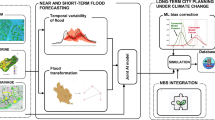Abstract
In the study reported in this paper an attempt has been made to develop a Cellular Automata (CA) model for simulating future urban growth of an Indian city. In the model remote sensing data and GIS were used to provide the empirical data about urban growth while Markov chain process was used to predict the amount of land required for future urban use based on the empirical data. Multi-criteria evaluation (MCE) technique was used to reveal the relationships between future urban growth potential and site attributes of a site. Finally using the CA model, land for future urban development was spatially allocated based on the urban suitability image provided by MCE, neighbourhood information of a site and the amount of land predicted by Markov chain process. The model results were evaluated using Kappa Coefficient and future urban growth was simulated using the calibrated model



Similar content being viewed by others
References
Batty, M. (1996). Urban change. Environment & Planning B, 23, 513–514.
Batty, M. (2001). Urban evolution on the desktop: simulation with the use of extended cellular automata. Environment & Planning A, 30, 1943–1967.
Batty, M., & Xie, Y. (1994a). Modelling inside GIS Part 1: model structures, exploratory spatial data analysis and aggregation. International Journal of Geographical Information Science, 8(3), 291–307.
Batty, M., & Xie, Y. (1994b). Modelling inside GIS Part 2: selecting and calibrating urban models using ARC/INFO. International Journal of Geographical Information Science, 8(1), 451–470.
Batty, M., & Xie, Y. (1994c). From cells to cities. Environment & Planning B, 21, 31–48.
Batty, M., & Xie, Y. (1997). Possible urban automata. Environment & Planning B, 24, 175–192.
Clarke, K. C., & Gaydos, L. (2001). Loose-coupling a CA model and GIS: long-term urban growth prediction for San Franciso and Washington/Baltimore. International Journal of Geographical Information Science, 12(7), 699–714.
Clarke, K. C., Gaydos, L., & Hoppen, S. (1997). A self-modifying cellular automaton model of historical urbanization in the San Francisco Bay area. Environment & Planning B, 24, 247–261.
Congalton, R. G. (1991). A review of assessing the accuracy of classifications of remotely sensed data. Remote Sensing of Environment, 37, 35–46.
Congalton, R. G., & Green, K. (1999). Assessing the accuracy of remotely sensed data: Principles and practices (1st ed.). Florida: CRC Press.
Jacob, N., Krishnan, R., Harmsen, K., & Murali Krishna, I. V. (2006). Spatial dynamic modeling through cellular automata for simulating land use change dynamics. International Journal of Geoinformatics, 2(2), 31–38.
Kiefer, R. W., & Lillesand, T. M. (2000). Remote sensing and image interpretation (1st ed.). New York: Wiley.
Li, X., & Yeh, A. G. O. (2000). Modeling sustainable urban development by the integration of constrained cellular automata and GIS. International Journal of Geographical Information Science, 14(2), 131–152.
Malczewski, J. (1999). GIS and multicriteria decision analysis (1st ed.). New York: Wiley.
Malczewski, J. (2006). GIS-based multicriteria decision analysis: a survey of the literature. International Journal of Geographical Information Science, 20(7), 703–726.
White, R. (2001). Cities and cellular automata. Discrete Dynamics in Nature and Society, 2, 111–125.
White, R., & Engelen, G. (1993). Cellular automata and fractal urban form: a cellular modeling approach to the evolution of urban land use patterns. Environment & Planning A, 25, 1175–1199.
White, R., & Engelen, G. (1994). Cellular dynamics and GIS: modelling spatial complexity. Geographical Systems, 1, 237–253.
White, R., & Engelen, G. (1997). Cellular automata as the basis of integrated dynamic regional modelling. Environment & Planning B, 24, 235–246.
Wu, F. (2001a). An empirical model of intrametropolitan land use changes in a Chinese city. Environment & Planning B, 25, 245–263.
Wu, F. (2001b). Simland: a prototype to simulate land conversion through the integrated GIS and CA with AHP-derived transition rules. International Journal of Geographical Information Science, 12, 63–82.
Wu, F. (2002). Calibration of stochastic cellular automata: the application to rural-urban land conversions. International Journal of Geographical Information Science, 16(8), 795–818.
Wu, F., & Webster, C. J. (2000). Simulation artificial cities in a GIS environment: urban growth under alternative regulation regime. International Journal of Geographical Information Science, 14(7), 625–648.
Wu, F., & Webster, C. J. (2001). Simulation of land development through the integration of cellular automata and multicriteria evaluation. Environment & Planning B, 25, 103–126.
Author information
Authors and Affiliations
Corresponding author
About this article
Cite this article
Maithani, S. Cellular Automata Based Model of Urban Spatial Growth. J Indian Soc Remote Sens 38, 604–610 (2010). https://doi.org/10.1007/s12524-010-0053-3
Received:
Accepted:
Published:
Issue Date:
DOI: https://doi.org/10.1007/s12524-010-0053-3




